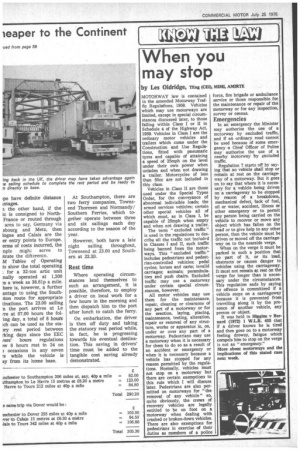When you may stop
Page 62

If you've noticed an error in this article please click here to report it so we can fix it.
by Les Oldridge, TEng (CE1), MIMI, AM1RTE
MOTORWAY law is contained in the amended Motorway Traffic Regulations, 1959. Vehicles which may use motorways are limited, except in special circumstances discussed later, to those falling within Class I or II in Schedule 4 of the Highway Act, 1959. Vehicles in Class I are the ordinary motor vehicles and trailers which come under the Construction and Use Regulations, fitted with pneumatic tyres and capable of attaining a speed of 25mph on the level under their own power when unladen and when not drawing a trailer. Motorcycles of less than 50cc are not included in this class.
Vehicles in Class II are those used under the Special Types Order, for the conveyance of abnormal indivisible loads; the armed services vehicles; certain other special vehicles all of which must, as in Class I, be capable of 25mph when empty and when not drawing a trailer.
The term " excluded traffic" is used in the regulations to describe all the traffic not included in Classes I and II, such traffic • being banned from the motorways. This "excluded traffic" includes pedestrians and pedestrian-controlled vehicles; pedal cycles; horses and carts; invalid carriages; animals; perambulators and push chairs. Excluded traffic may use a motorway under certain special circumstances, however.
All motor vehicles may use them for the maintenance, repair, cleaning or clearance of any part of a motorway or for the erection, laying, placing, maintenance, testing, alteration, repair or removal of any structure, works or apparatus in, on, under or over any part of a motorway. Pedestrians may use a motorway when it is necessary for them to do so as a result of an accident or emergency or when it is necessary because a vehicle has stopped for any reason permitted by the regulations. Normally, vehicles must not stop on a motorway but there are certain exemptions to this rule which I will discuss later. Pedestrians are also permitted on motorways for "the removal of any vehicle" so, quite obviously, the crews of recovery vehicles are legally entitled to be on foot on a motorway when dealing with crashed or broken-down vehicles. There are also exemptions for pedestrians in exercise of their duties as members of a police
force, fire brigade or ambuliance service or those responsible for the maintenance or repair of the motorway or for any inspection, survey or census.
Emergencies
In an emergency the Minister ?nay authorise the use .of a motorway by excluded traffic, and if an ordinary road cannot be used because of some emergency a Chief Officer of Police may authorise the use of a nearby motorway by excluded traffic.
Regulation 7 starts off by saying that no vehicle shall stop or remain at rest on the carriageway of a motorway. But it goes on to say that where it is necessary for a vehicle being driven on a carriageway to be stopped by reason of a breakdown, mechanical defect, lack of fuel, oil or water, accident, illness or other emergency or to permit any person being carried on the vehicle to recover or move any object which has fallen on the road or to give help to any other person, then the vehicle must be driven or moved off the carriageway on to the nearside verge.
When on the verge it must be parked in such a position that no part of it, or its load, obstructs or causes danger to vehicles using the carriageway. It must not remain at rest on the verge for longer than is necessary under the circumstances. This regulation ends by saying no offence is committeed if a vehicle stops on a carriageway because it is prevented from travelling along it by the presence of another vehicle, any person or object.
It was held in Higgins v Bernard (1972) 1 W.L.R. 455 that if a driver knows he is tired and then goes on to a motorway feeling drowsy, fatigue which compels him to stop on the verge is not an "emergency."
More about motorways and the implications of this stated case next week.




































































































